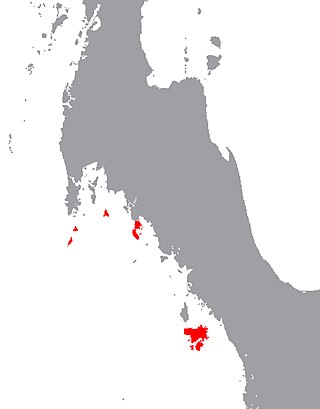Top Qs
Timeline
Chat
Perspective
Urak Lawoiʼ language
Austronesian language spoken in Thailand From Wikipedia, the free encyclopedia
Remove ads
Urak Lawoiʼ or Urak Lawoc (Urak Lawoiʼ: อูรักลาโวยจ, [ˈurʌk ˈlawʊjʔ]) is a Malayic language spoken in southern Thailand.
The Orang (Suku) Laut who live between Sumatra and the Malay Peninsula speak divergent Malayic lects, which bear some intriguing connections to various Sumatran Malay varieties.[2]
Remove ads
Phonology and orthography
Summarize
Perspective
Vowels
- In closed syllables, some vowels change their quality:
- /a/ becomes [ʌ] (/ˈrawak/ [ˈraˑwʌk] 'space').
- /i/ becomes [ɪ] (/ˈbaliʔ/ [ˈbaˑlɪʔ] 'return').
- /o/ becomes [ʊ] (/ˈproc/ [ˈprʊiʔ] 'stomach').
- Epenthetic /j/ and /w/ are added after high vowels /i/, /u/ respectively (/ˈsiˑjak/ 'light', /ˈbuˑwak/ 'to throw away').
- Vowels are somewhat allophonically lengthened in stressed open syllables.
- Vowels other than /ə/ are slightly nasalized after nasal consonants. If the following syllable has /w/, /j/ as the onset, this onset is also nasalized (/məˈnaŋɛh/ [məˈnãˑŋɛ̃h] 'to cry', /ˈɲawa/ [ˈɲãˑw̃ã] 'body, self').
Notes: In the Thai script, the left column represents diacritics for open syllables, while the right one for closed syllables. For syllables with vowel ö, before consonants k, m, n, ng, p, and t, the vowel is not written. Similarly, the diacritic for a is not used before q. Any vowels with separate closed syllable diacritics have an inherent value of /-ʔ/ when not used with a succeeding consonant.
Consonants
- [t͡ɕ] and [t͡ɕʰ] allophones are influenced by Thai, whereas [d͡ʑ] is influenced by Malay.
- Aspirated consonants and /f/ only appear in loanwords (mostly from Thai).
- Phonetically, /-c/ and /-s/ is pronounced [-jʔ], and [-jh] (after back vowels and /a/) or [-h] (after front vowels), respectively, syllable-finally.
- /l/ becomes [l] after /i/, /ə/, otherwise [ɭ] in syllable-final positions (/ˈlihəl/ [ˈliˑhəl] 'neck' vs. /ˈbumɔl/ [ˈbuˑmɔɭ] 'doctor').
- /ər/ is compensatorily lengthened to phonetically long [əə]. In stressed positions, the vowel cluster fluctuates between [ɽ], [ər], [rə].
- The coda stop /k/ after a front vowel becomes [kx] (/ˈkamek/ [ˈkaˑmekx] 'sheep').
- Syllable-initial stops /p/, /b/, with the same syllable containing a back vowel and coda /c/, are labialized to /pw/ and /bw/ respectively (/səˈboc/ [səˈbwʊjʔ] 'to utter').
- /-j/ and /-w/ can be treated as a part of diphthongs or triphthongs.
- /-l/ only exists in the Phuket dialect.
Stress and intonation
Urak Lawoiʼ does not have tones, except in Thai loans. Words are usually stressed in penultimate syllable, except if the expected stress is placed on the pre-syllable (e.g. open syllables containing /ə/, but not /ər/) the stress moves into the next syllable. Urak Lawoiʼ also has global intonation — for instance, interrogative sentences have rising intonation and negative sentences have lower-pitch intonation.
Remove ads
References
Further reading
Wikiwand - on
Seamless Wikipedia browsing. On steroids.
Remove ads

